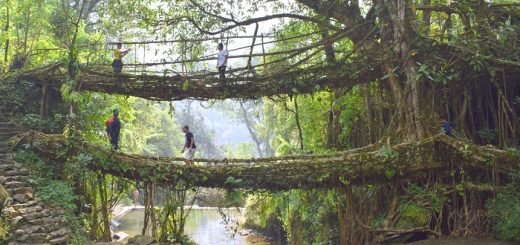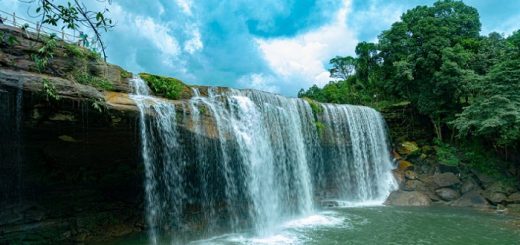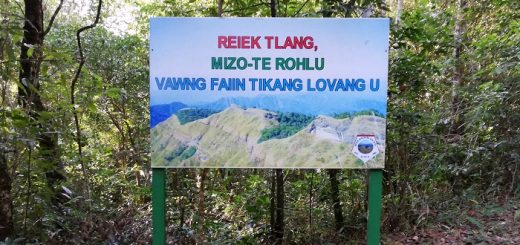Trek To Rainbow Waterfall In Meghalaya: Detailed Guide To Rainbow Falls Meghalaya
Any traveler visiting Meghalaya will find one thing in abundance, i.e., the waterfalls in the state. Meghalaya is blessed with many spectacular waterfalls, and whoever has visited Meghalaya will recon with it. The geography and its climate favor the formation of waterfall throughout its length and breadth. In my three days of traveling in Meghalaya, I encountered some of the spectacular and most famous waterfalls of the state. These waterfalls are not only popular in Meghalaya but also in entire India. A few waterfalls of Meghalaya are well-known in India, but the majority of them are not known to the people outside the state. There is limited information available on the internet but gradually increasing. For example, most of the travelers in India are aware of the Noh-Ka-Likai Falls, but the same is not correct for Wei-Saw-Dong Falls. Moreover, the state tourism department website also lists a limited number of waterfalls present in the state. I faced a similar situation when I got to know about another beautiful waterfall in Meghalaya, i.e., the Rainbow Waterfalls. Therefore in this article, I will be sharing my experience of Trek to Rainbow Waterfalls In Meghalaya. I will also share where the Rainbow waterfall is situated, how to reach Rainbow Waterfalls and other tips required for a successful visit to rainbow waterfalls.
Initially, when I was making my itinerary for Meghalaya, I planned to trek the double-decker root bridge and then return to Cherrapunjee town. The day I was starting my trek, my homestay owner informed me about the Rainbow Waterfall. He said if I can trek further from the Double-Root Bridge, I can see the best waterfall in Meghalaya. He also informed me the waterfall is known by Rainbow Waterfall and requires a considerable amount to trekking. Initially, I had reserved the third day of my trip for the double-decker root bridge, and after knowing about Rainbow waterfall, I decided to trek further and visit the waterfall. Throughout my stay in Meghalaya, I blindly followed the suggestions provided by the homestay owner. I was in the notion that his recommendations were fantastic and never disappointed me.
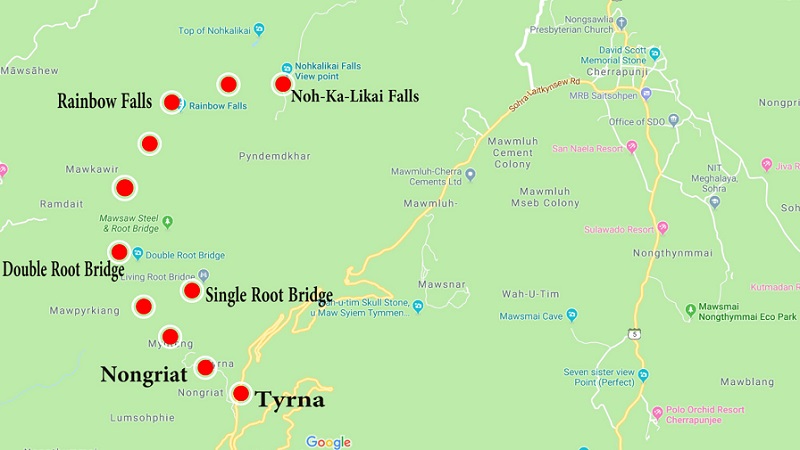
Also Read: Trek To Double Root Bridge In Meghalaya
Qucik Navigate:
Location of Rainbow Waterfall In Meghalaya
The waterfall is situated in the town of Cherrapunjee in the East Khasi District of Meghalaya. The waterfall lies amid dense forest and is not easily accessible like the other waterfalls in the state. To get a glimpse of the waterfall, one has to trek for around 2:30 hours to reach the point from where the waterfall is visible. Moreover, reaching the base of the waterfall is, again, a daunting task. No stairs or path leads to the bottom of the waterfall, and one has to do a rock climbing to reach the base of the waterfall. Due to the complexity it posses, the waterfall is untouched by most of the tourists visiting Cherrapunjee. The path to the Rainbow Waterfall lies en route the Double-Decker Root Bridge. After reaching the double-decker root bridge, 45 minutes trek leads to the Rainbow waterfalls.

My Trek To Rainbow Waterfall In Cherrapunjee
In my last article, I narrated my trek to the double-decker bridge, and I will be continuing from the double-decker root bridge. After spending a considerable amount of time there, I started my trek for the Rainbow waterfall. There is only one path that leads to the Rainbow waterfall from the double-decker root bridge. The trek route is not perfect as in the case of the double-decker bridge, and after walking for a few hundred meters, the path started deteriorating. After walking for around 15 minutes, I reached a bridge made up of steel wires and looked like the bridge from the amazon rainforest. Special attention is required to cross the bridge as the bridge is made up of steel wires and no wooden planks. Once I crossed the bridge, I started trekking on the other side of the valley, and the only way to find the route was the foot marks left by early travelers. On the way from the Double-Decker bridge to the Rainbow waterfall, I noticed many more root bridges in their early stages of development. The presence of rock boulders gave the impression that local people are constructing a track till Rainbow Falls, but it was in its early stage of development.

The route is not hard when compared with ascending stairs of the Double Root bridge. In the next 30 minutes, I reached a point where one path was going to the bottom of the hill and another to the Rainbow Falls. Returning travelers informed me that there is a pool at the bottom and an excellent place for recreation. Since my priority was the Rainbow Falls, I decided to visit the pool while returning and continued towards the waterfall. After another twenty minutes of walking, I saw a small shop and my instinct said that the waterfall is nearby. As on the route from the double-decker bridge to Rainbow falls, there is no shop, and this was the first shop I saw in the last one hour of walking. Once I reached the shop, I got a glimpse of the spectacular Rainbow Falls. The waterfall was way out of the league of other waterfalls in India. The water looked bright and bluish, and the roaring sound further enhanced the excitement. As I observed the waterfall from the top, I realized why it is called the Rainbow falls. The turbulent flow of water forces the water to form small droplets after hitting the rock. When it hits the rocks, the droplets act as a tiny prism spreading all the seven colors of the Rainbow. Though I reached near to the waterfall, and it was in my sight, reaching to the base of the waterfall was a challenging task. There was no way to reach the bottom of the fall, and I had to hold rocks to climb down. Proper precaution needs to be taken care of due to the continuous flow of water, the stones are slippery, and a small mistake can be fatal. I saw a few girls dropping off their plan of going down as the route looked scary.
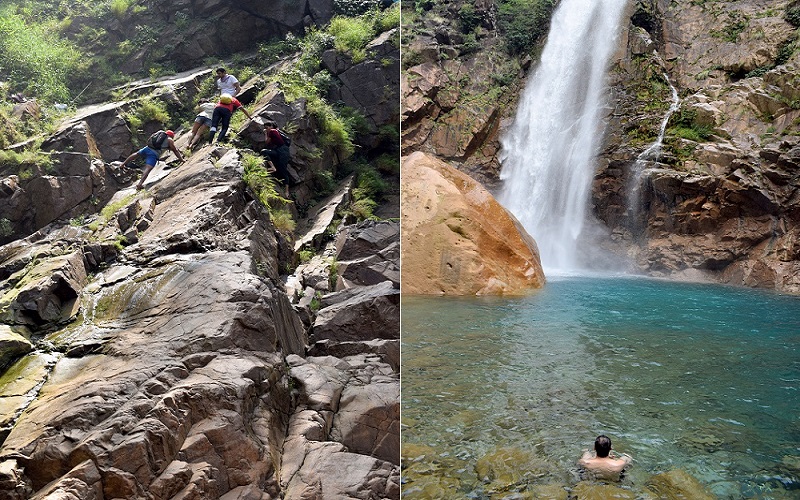
I took five minutes to climb down and reached the foot of the waterfall. I can’t explain how delighted I was to take a dip in the cleanest water I ever saw in my life. Typically, when water falls from such height, the nearby water gets muddy, but here the case was different. The turbulent flow, the height, and speed, all were neutralized by the pool. I mounted my GoPro to the nearby rock and went straight into the pool. Though I am not a good swimmer and hardly know anything about swimming, I thought to give a try. It won’t be wrong in saying that I looked like a buffalo enjoying the water in the pond as I was doing all sorts of stupid acts I hardly did in my life. From jumping to Swiming, and running to falling, the show went on for non-stop 45 minutes. I relaxed in the pool for around 45 minutes and completely forgot that I have to climb 3500 stairs on returning. I met a guy, and he was also traveling solo and trekked all the way to the Rainbow Falls. He asked me to click a few pictures of him, and I obliged to it. I understand the problem with traveling solo; we don’t get enough pictures of ourselves. After clicking his few pictures, I handed over his phone and then picked up my camera and tried getting a few images. Now it was time to bid AIDEU to the best waterfall I visited in my life. The Rainbow waterfall is fantastic not because the water is clean but also because a few travelers visit it, thus less crowded.
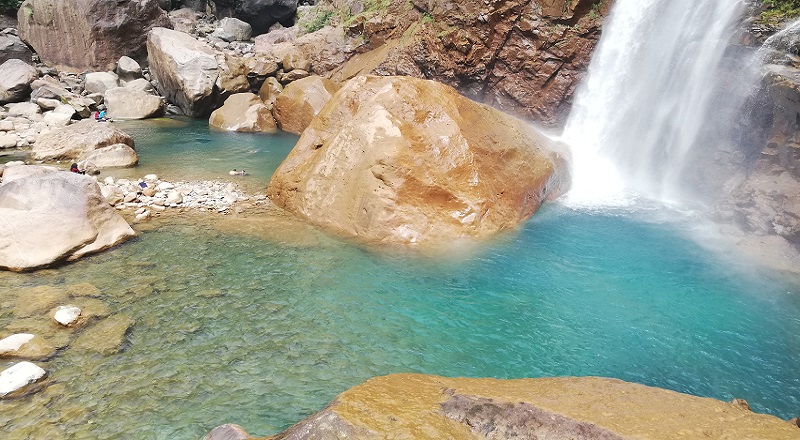
While I was planning to return, I thought to see the path that leads to the Noh-Ka-Likai Falls, but I didn’t find a single way leading anywhere. It looked like all the track ends at the Rainbow falls. Now I realized why my homestay owner said that to trek the Noh-Ka-Likai falls, a guide is mandatory. Once I was set to move, I packed my camera bag, powered off GoPro, and started climbing the rock though which I descended.
While returning, I started walking quickly to cover the time I used in Rainbow fall took 15 minutes to reach the tri-point where the path leads to the tarn. After reaching the pool, I saw a group from Pune enjoying there. The water in the pool looked like the replica of the water at Rainbow falls, and I clicked a few photos. The members sitting there advised me that I should take a dip in the pool to feel its smoothness, but I had already experienced something better. I told them that while returning, they should go to the Rainbow Falls else they will miss something they will regret throughout there life. After explaining them about the path and time to reach Rainbow Falls, I parted my way and started returning to the Double-Decker Bridge. I aimed to reach the double-decker bridge by 2:30 PM so that I can reach my homestay by the time it is evening. In the next 30 minutes, I reached the double-decker bridge, and after a short break near one of the shops, I continued my journey to the Tyrna Village from where I started my trek in the morning.
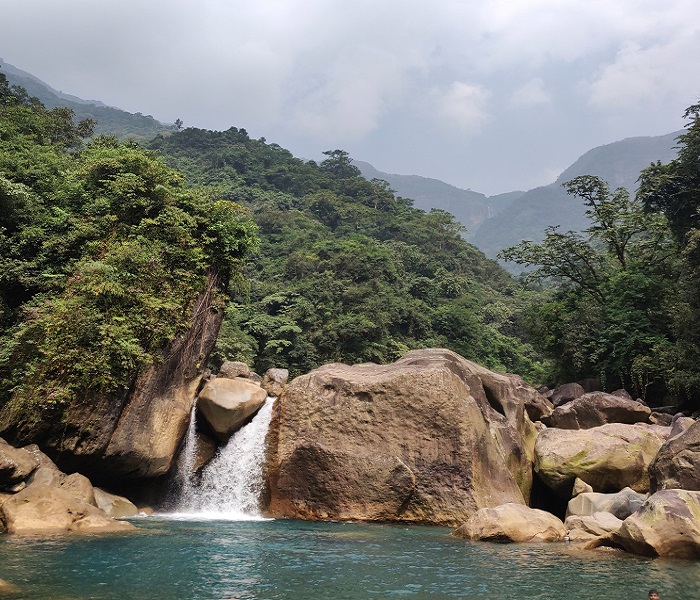
Why Should One Visit the Rainbow Waterfall?
Although there is no thumb rule to explain this, I am assuming anyone visiting Meghalaya, have already visited a few waterfalls situated in other parts of India. I have been to some of the well-known waterfalls in India like the Jog Falls in Shimoga, Tiger Falls in Chakrata, and Birthi Falls in Munsiyari, but Rainbow Falls is beyond comparison. The fewer crowd make it more serene, unlike Kempty Falls in Mussourie where hundreds of people struggle in one small pool.
The Complexity of Rainbow Waterfall Trek
The trek to the Rainbow waterfall is moderate and requires normal walking, excluding few patches. Rainbow waterfall lies some 2.5 to 3 kilometers from the Double Decker Root Bridge and can be reached in an hour depending upon the walking speed. One thing to remember, there is no paved way as it is in Double-Decker Root Bridge, and the path diminishes after crossing the steel bridge. From bridge onwards, the trail is mostly made up of sand and rock boulders. As I was traveling in the post-monsoon season, there was no mud, and the route was smooth. In case you are going during monsoon, it might be a difficult task to reach the waterfall.
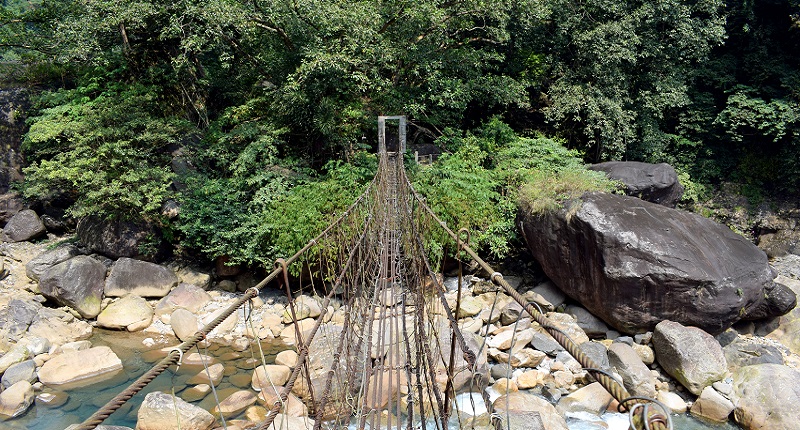
Accommodation At The Rainbow Waterfall
There is no accommodation available near the Rainbow waterfall, and the closest place where one can find accommodation is the Nongriat Village. The waterfall is an hour trek from the Double-Decker root Bridge, and only in recent years, travelers have started going to the Rainbow Waterfall. Therefore, the area has no human settlement as of now. The best way to explore Rainbow waterfall is to stay at Nongriat Village and start for the Rainbow waterfall early in the morning.
Availability of Shops and Other Amenities
Again there are no shops on the way to the Rainbow Waterfalls, and after crossing the Double-Decker Root Bridge; the next shop is near the waterfall. The shop is a smaller one, and you can expect only water, juice and maggie. It is advisable to carry necessary items before leaving the Double-Decker Root Bridge.
Network Connectivity Around Rainbow Waterfall
The network connectivity drops as Rainbow waterfall approaches. I still remember I was able to receive a call at the tri-point, but as I arrived at the waterfall, there was no network on my mobile. Reliance Jio might have coverage over there, but I was carrying Airtel and Vodafone SIM, and both had no network.
Thanks for reading the article, if you have any query, let me know and if you liked my travelogue, do read my other post as I am covering most of the states in North-East India.

